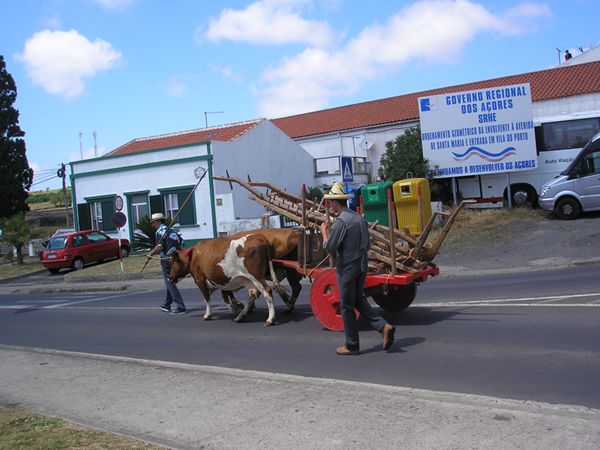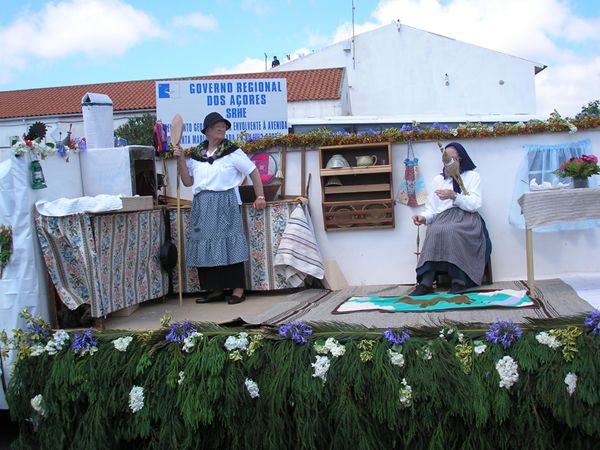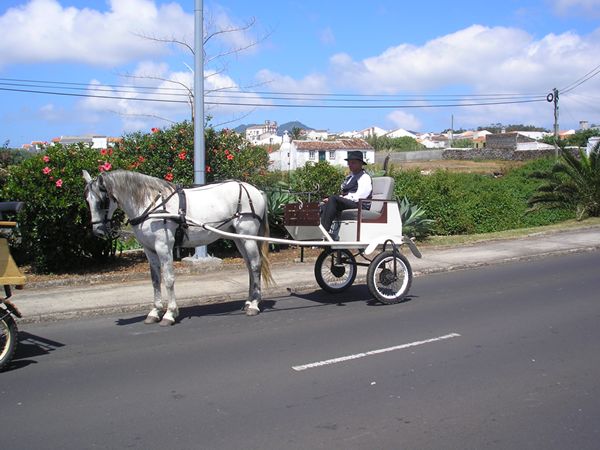The Hills are alive with the Sound of Music

andromeda of plymouth
Susan and Andrew Wilson
Tue 29 Jun 2010 20:57
the higher slopes of the mountains of Santa Maria – wonderful and quite
unexpected. We shared a hire car with Sue, Liz and Ju from Tamar Swallow
for a couple of days to see the island and Andrew was rechristened Charles
as our chauffeur for the duration. He stood up to the task very well not
even complaining when one or other of us would suddenly burst into song as
some vista or circumstance popped words into our heads and at one stage
when we were watching a little red vehicle negotiate the roads below us –
“postman pat” was heard.
Santa Maria although not that very large, certainly has one very
interesting, very steep road in pretty poor condition, with many, many
twists, turns and hairpin bends leading to Sao Lourenco on the eastern
side of the island. We all breathed a collective sigh of relief when we
found the flat road along the shore, no more so than the driver (sorry I
mean Chauffeur)! The decision was made not to attempt to go back up by the
same road in case we would have had to get out and push and thankfully
there was a slightly less hair-raising alternative. However most of the
rest of the main roads were in good condition although steep hills were
found all around the eastern side of the island. The western side is
relatively flat, reminding folks of western Scotland and the stone walls
lining many of the roads, of Cumbria. Alas the low cloud prevented us
seeing the best of the views from the island’s high spots, but we did
manage to see lots of very spectacular vistas, buzzards and well fed
cattle.
On Monday we all were helping resolve an anomaly in one of the pilot
guides by checking bearings and the position of one of the lights on shore
in a nearby bay. Interesting stuff.
The island is primarily agricultural with some fishing. Many of the steep
hillsides are terraced and quite a lot contain bananas and grape vines and
are actively managed. A high proportion of the houses seem to be second
homes – very grand in nature with extensive manicured and well maintained
gardens, but devoid of life. Many of the smaller houses in the small
villages have their doors unlocked as evident by the keys left in the
locks. It is a very friendly and peaceful island and it’s not hard to see
why folks return regularly. We certainly like it here on Santa Maria.
On the second day of our stay we stumbled on a procession celebrating the
feast of St John. Numerous floats (small flat bed trucks) were displaying
the traditional crafts of the original islanders. These ranged from wine
making through to bread making, laundry (this float had a mountain stream
running from above the cab and even a washing line), drying corn and
milling it, fishing, clobblers mending and making shoes, tavernas, wool
crafts (from carding the wool to making a garment)and traditional milk
delivery carts pulled by cows, and milk churns on the sides of donkeys and
mules. Everyone involved seemed to be really enjoying themselves,
especially the fishermen who were pretending they were at sea spotting
shoals and excitedly telling everyone about it, and most had either the
name of the village on the front of the float, or on a banner proudly held
by some of the children, and all in traditional costumes. A very festive
and unexpected treat for us. The festival is one of the agricultural
celebrations that occur quite frequently in the Azorean calendar. There
was also a livestock show featuring the usual sheep, cattle, poultry,
goats, rabbits and horses, as well as singing and dancing displays and
quite a few parties.
We have caught up with Christopher Columbus yet again – there is a
monument and small chapel in a tiny village called Anjus to him – he
certainly got around. He came ashore here on his return from his first
trip to the Caribbean to pray, so it is alleged.
We plan to head north to Ponta Delgada on the island of Sao Miguel later
this week, following Tamar Swallow who left ahead of us. It’s a journey of
about 55 miles and then we will see how we want to tackle visiting some of
the other islands. A lot will depend on the wind direction – we don’t
really want to spend too much time beating into a choppy sea any more than
we can help. As the majority of the winds at this time of year are
Westerlies this means we will need to do some careful planning. Meanwhile
there is the marina to enjoy, catching up with the various folks arriving
here and the plenty of time so sit and contemplate in the warm balmy
breeze and sunshine.
More in due course......
Andrew and Susan
s/v Andromeda of Plymouth



















